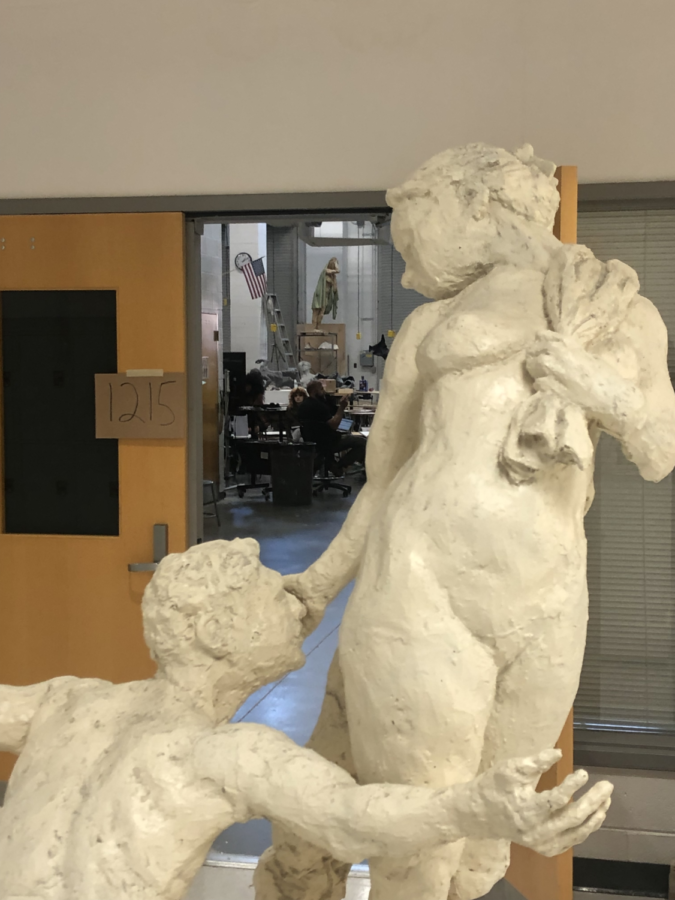Carver Center Culture as a Model for Other Schools
What the atmosphere of an art school can provide for other environments.
 One of the most common things people consider striking about Carver Center is that our community is built of highly dedicated individuals. And while it seems pretentious to constantly mention this fact, it is hard to confront the authentic nature of our community without really immersing yourself in the vigorous and studied practice which goes into students’ art. I believe that it’s important as a matter of our culture here at school to recognize this commitment, both as a factor of the art people create but also as an integral part of the dynamics of our community. Recognizing this benefit is crucial in seeing why Carver Center, as an educational space, should serve as an example for building community in other institutional environments.
One of the most common things people consider striking about Carver Center is that our community is built of highly dedicated individuals. And while it seems pretentious to constantly mention this fact, it is hard to confront the authentic nature of our community without really immersing yourself in the vigorous and studied practice which goes into students’ art. I believe that it’s important as a matter of our culture here at school to recognize this commitment, both as a factor of the art people create but also as an integral part of the dynamics of our community. Recognizing this benefit is crucial in seeing why Carver Center, as an educational space, should serve as an example for building community in other institutional environments.
In larger primes, incoming Juniors have the opportunity this year to specialize their study, through specialty classes like sculpting for visual, or poetry for literary, etc. Even at the outset of the year, one can’t help but notice the serious and energetic way the students address their work given this new opportunity.
The beginning of this year, having finally started to feel like we’re getting out of COVID, sees the school in its most raw state of activity. From exploring the school, it is impossible not to feel the energy students have brought into the building. Entering the sculpture studio, I noticed ten students transfixed over lumps of clay on rotating daises. The instructor, Mr.Cypressi, explains, mantra-like, the manner of form they should be focusing on in their work: “Structure, gesture, and proportion are all that you need.”
At his direction, the students work roughly with the clay, with intensity, but with no anxiety, no fear of mistakes. They take wide sweeping cuts with knives, break and bend and push to yield to form the hunch of the back and arch of the arms-crossed-over-legs position of the model. They follow the tempo of a periodic ticking of a clock meant to time the student’s sculpting and alert when their model should be turned.
A menagerie of solemnly visaged, half finished, and expressive sculptures are arrayed around them, studying them with the same contented examination that the students carry towards their own model. In a way it feels like the history of activity that has occurred in this room is placed at the forefront of the space, making this, as most classrooms in the school, feel like a lived in, vibrant environment. Crucially, that feeling is immediate and palpable, and it is not formalized or confined by arbitrary design decisions in the space. Other places might do well to remove their Roman columns when not needed and make room for a half finished project or two: A dynamic space elicits dynamic habitants.
Over the course of mere minutes, timed out by the ticking clock, the students have taken a rough brown lump and formed it into an acute replica of the model, but with none of the “dressing” they know not to focus on. The best part about experiencing this immediate creativity is the meditative feeling it evokes. Time passed in an instant as their work seemed to evolve under strokes so practiced as to appear they barely touched the clay. After the exercise, one student commented, “It’s really relaxing to me. Like, I’m not making decisions, I am just… challenging myself to make the best thing from my perspective.”
This is another crucial takeaway about building a dynamic space: For learning and growth, it is crucial that one’s emotional state and mental perspective are allowed to open up, so that they can allow their practice to infiltrate deeply and allow themselves a greater freedom of creativity and critical analysis. When you go into a Carver Center classroom, most teachers have taken the effort to bring to the fore the dynamism of the space, and encourage that same dynamism in their students through freedom and independence, so that students who have subconsciously made their commitment to their craft and the school will bring that oath to the fore of their interactions within that studio and that school community. Again, it might do well in other spaces to remove the barriers against creativity and criticality, and build from there a dynamic space that people hope to honor in refinement of their craft.
The half finished expressive strokes of the model remained transfixed in the clay, left on their daises, as the students left. Mr. Cypressi, still sedate, begins collecting his teaching materials from the day. While Carver is often lauded for its intensity of creative activity, it is as much a place defined by an air of energetic creation as it is a place that is shaped by an aura which brings people to submerge themselves in their creative work.
We have the opportunity, as members of the Carver Center community, to shape the way this school functions, and crucially the type of people it builds. Many schools, and other institutions, operate under the false assumption that people are static and therefore must be precisely aligned and regulated to perform even basic tasks, or all cohesion of the community or the operation will be lost. Art in schools is often lauded as a tool to improve cognitive ability and student emotional growth, but fundamentally I think one thing that comes with art that can be exported to that same effect is the type of dynamic spaces artists create. Give people more freedom, more capacity to be creative, and bring them in with a commitment towards their work, and even those activities that end up being the side performances to that work will flourish by the way that those individuals build a stronger and more dynamic community around themselves. For Carver Center students, this is natural, but only because Carver has been designed towards this end, and more importantly because many members of the Carver Center community intentionally orient the community in that direction for the benefit of our art. The main thing to realize is that art is not the only thing that benefits from that intention.





